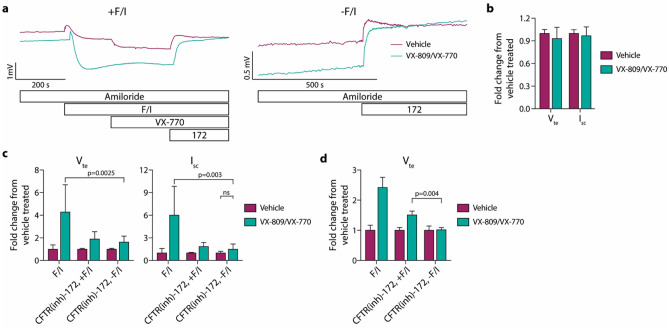Figure 2.
F508del/F508del CFTR nasal epithelia demonstrate low levels of spontaneously active CFTR-mediated ion transport that are slightly increased following 24 h VX-809/VX-770 treatment. Epithelia were analyzed in an Ussing chamber using the same methods as for non-CF epithelia, with the addition of acute 1 µM VX-770 between forskolin/IBMX (F/I) and CFTR(inh)-172 treatments for Panels (a–c). (a) Representative tracings of epithelia analyzed after treatment with vehicle vs. VX-809/VX-770. (b) Baseline values of transepithelial potential difference/voltage (Vte) and short-circuit current (ISC) were normalized to the vehicle values in donor-matched replicate epithelia. (c) Responses to F/I or CFTR(inh)-172 [in the presence (+ F/I) or absence (-F/I) of F/I] treatments were normalized to the change in values in vehicle-treated epithelia. (d) Epithelia from a single donor were analyzed without acute VX-770 treatment (n = 3 replicates per condition). For Panels (b, c), n = 3 donors with 3 replicates per donor/condition. For data shown in Panel c, VX-809/VX-770 treatment resulted in significant increases in F/I and CFTR(inh)-172 for all cases (p < 0.003) with the exception of spontaneous CFTR-mediated changes in Isc.

